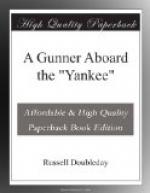Personal impressions in battle have been described in prose and poem until the subject is hackneyed, but it may be of interest to note that the impressions experienced by the novices in naval warfare manning the “Yankee,” during the bombardment of Santiago, consisted mainly of one feeling. It was well-voiced by “Hod,” who said many days later:
“I felt just as I did one time when I attended Barnum’s circus in Madison Square Garden. They had three rings, two platforms, a lot of tight-ropes and trapezes and other things all going at the same time. Before I had been in the place three minutes I was wishing for a hundred eyes. And that is the way I felt at Santiago.”
What we saw of the bombardment was limited to the range of our gun port, but that little was worth all the hardships and toil and discomforts of the whole cruise. The spectacle of the fleet itself was almost enough. To see the great ships ploughing through the water, each enveloped in a shroud of smoke, shot here and there with tinges of ruddy flame; to see that mighty line swinging and swaying in front of the enemy; to see the shells land and explode in fort and battery; to see the great gaps torn in cliff and earthworks; to see the geyser-like fountains of water spout up here and there as the Spanish shells struck the surface of the bay—to see all this, and to hear the accompanying thunder and booming of the guns, was payment in full for coal handling and standing watch and “Government straight.” Not one of the “Yankee” boys would have missed the spectacle for anything earth could offer.
[Illustration: On the gun deck during the bombardment]
During the second hour of the attack we were enabled to observe the work being done by other vessels of the fleet. Near us was the gallant “New Orleans,” the ship purchased from Brazil. Her foreign build made it easy to distinguish her, and, as she was the only craft using smokeless powder, she presented a prominent mark. The guns on board the “New Orleans” were being served rapidly and with precision, and we saw a number of shots strike well within the limits of the batteries.
At our end of the line the flagship “New York,” the “Iowa,” and the “Oregon” were pouring an appalling fire into some new earthworks near Morro Castle. It was seen that but very few shots were sent in the direction of the latter, and it transpired that Admiral Sampson had issued strict orders to the fleet to avoid endangering Lieutenant Hobson and his brave companions, who were supposed to be imprisoned in old Morro. Before the end of the second hour the “New York” and the “New Orleans” had succeeded in completely silencing Cayo Battery, dismantling the guns and wrecking the outer fortifications.
At the other end of the line Admiral Schley’s division was doing splendid work. We could see the “Massachusetts,” “Brooklyn,” and “Texas” move in toward shore and open fire at close range. It was a stirring sight, this mighty duel between warships and forts. As compared with the cliffs and hills of the land, the ships seemed veritable pigmies, but in this strife the pigmies were all powerful.




